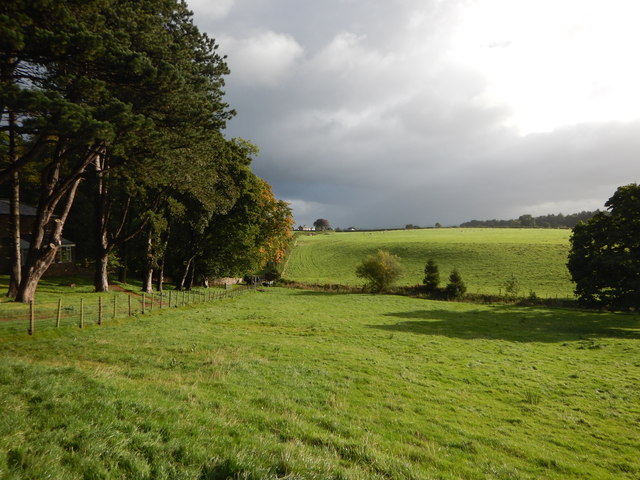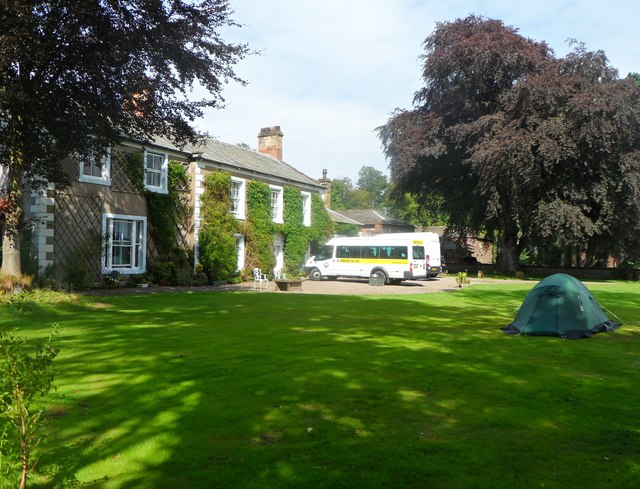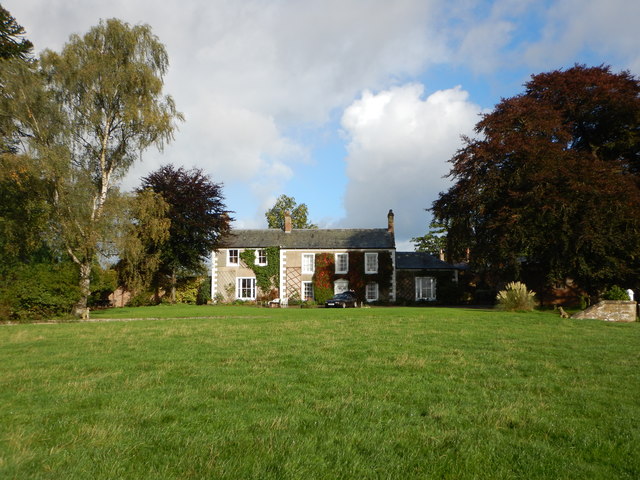Topics > Northumberland > Civil Parishes in Northumberland > Kirkwhelpington Civil Parish > Kirkwhelpington Parish, 1855
Kirkwhelpington Parish, 1855
Extract from: History, Topography, and Directory of Northumberland...Whellan, William, & Co, 1855.
KIRKWHELPINGTON is a parish comprising the townships of Bavington (Great), Capheaton, Catcherside, Coldwell, Crogdean, Fawns, Hawick, Kirwhelpington, and Welpington (West). It is bounded by the parishes of Elsdon, Hartburn, Coursenside, and Thockrington, and comprises an area of 13,351 acres. The population in 1801, was 714; in 1811, 814; in 1821, 793; in 1831, 789; in 1841, 705; and in 1851, 679 souls. The township of Hawick was given to this parish in 1847, in exchange for the townships of Little Harle and West Harle, which were transferred to Kirk Harle parish. This extensive district consists principally of more lands, which, however, afford excellent pasturage for sheep and cattle, and in some parts of the parish the soil is well suited for the purposes of the dairy. The salubrity of the atmosphere in this part of the country is much celebrated, and instances of longevity are not at all uncommon.
BAVINGTON (GREAT) is a township and hamlet, the property of James D Shaftoe Esq. who is also Lord of the Manor. The township comprises an area of 1,565 acres, and its rateable value is £1,344 10s. 2d. The number of its inhabitants in 1801, was 82; in 1811, 75; in 1821, 74; in 1831, 70; in 1841, 69; and in 1851, 78 souls. The hamlet of Great Bavington is situated 3 miles South of Kirwhelpington. Here is a Scotch Presbyterian Chapel, which was erected in 1725, and is now under the pastoral care of the Rev. Alexander Forsyth, who has established a very superior school here, in which the highest branches of education are taught by Mr. James Anderson. A neat “Manse” is at present (1854) in course of erection.
DIRECTORY
|
Rev. Alexander Forsyth, Barrington Manse James Anderson, teacher Jacob Carr, Mason, Ladywell Thomas Finling, Shoemaker |
Farmers Thomas Hemsley, New Housetead Simon Lamb, Clay Walls William Stephenson and Richard Weddle, Campwell |
CAPHEATON, a township and village in the above parish, comprises 2,213 acres, and its population in 1801, was 208; in 1811, 222; in 1821, 225; in 1831, 232; in 1841, 213; and in 1851, 226 souls. Sir John E Swinburne is the proprietor of the whole township and Lord of the Manor. This beautiful district has been the property of the Swinburne family from a very early period. Sir John Swinburne was created a baronet in 1660, and that title has been borne by his descendants ever since. The village of Capheaton is situated 4 miles S.S.E. of Kirwhelpington. Here is a school which has been erected by the Lord of the Manor, and is now conducted by Mr William Turnbull. CAPHEATON HALL, the seat and property of Sir John E Swinburne, Bart. is a handsome edifice, erected in 1668, from the designs of Robert Trollop, the architect of the old exchange, at Newcastle, and of the present Mansion House, at Netherwitton. The library here contains one of the most extensive and best selected collections in the north of England. The pleasure grounds are laid out in a tasteful manner, and the clumps of trees which are scattered over the land, render the scenes singularly beautiful. In 1745, some labourers employed in making a hedge to the lane, since that time called silver lane, about half a mile north of Capheaton, found several Roman coins, and a Roman service of plate, consisting of various vessels of silver. They secreted and sold all the coins, and after breaking the bottoms out of some of the vessels, and the handles and ornaments of others, disposed of them also, except the following, which were presented to the Lord of the Manor, viz.: one silver dish entire, weighing 26 oz ; the bottoms of three others; 3 handles adorned with beautiful figures in relief; part of another carved handle; a figure of Hercules Antoeus wrestling; and a figure of Neptune. These, with a few fragments recovered by the honesty of a silversmith in Newcastle, were presented by the present baronet to the British Museum.
BIOGRAPHY :- Among the members of the ancient family of Swinburne, none, probably, experienced vicissitudes so romantic as Sir John Swinburne the first baronet. He was sent, while a child, to a monastery in France, where a Northumberland gentleman, of the Radcliffe family, accidentally visiting the place, recognised his features as those of the Swinburne's. On inquiring of the monks, how the boy came there, the only answer they could give, was that he came from England, and that the payment for his board and lodging was annually remitted. On questioning the boy himself, it was, however, found that his name was Swinburne, which, with the account of his father's death, and his own mysterious disappearance from Northumberland, induced this superior of the monastery to allow him to return home, where, in an inquest specially empannelled for that purpose, he identified himself to be the son of John Swinburne and Ann Blount, by the description he gave of the marks upon a cat, and a punch bowl, which were still in the household . Charles II, in 1660, regarding his loyalty and zeal for the restoration, and advanced him to the dignity of a baronet, in the patent for which, he styled him “virum patrimonio censu, et morum probitate spectbilem”. He was singularly easy in his afflictions, and in his prosperity favourable to his neighbours both by hospitality and other good qualities, which gained him the respect and affection of his country. He died on the 19th of June, 1706.
POST OFFICE, CAPHEATON. Ann Dodson, post mistress. Letters arrive here, from Newcastle, at 12:30 noon, and are dispatched at 7:30 PM
DIRECTORY
|
CAPHEATON SCHOOL, William Turnbull ,master Davison Thomas, butcher, Clock Mill Dobson Anne, shopkeeper Dobson James, tailor Gullon William, blacksmith Irvine John, gardner Swinburne, Sir John Edward, Bart. Tone Edward, land agent Tone Mr Nathaniel |
Farmers Collie William, Make’m Rich Dryden John and George, Sandy Braes Henderson Thomas, Parkhead Reed John, Whitehouse Robinson Joseph, Hillhead Rochester Richard, Capheaton, Newhouses, and corn miller, Clock Mill Thompson John, Frolick |
CATCHERSIDE township is situated 2 miles north of Kirk Welpington. It contains 593 acres., and its rateable value is £285. The number of inhabitants in 1801, was 13; in 1811, 12; in 1821, 15; in 1831, 14; in 1841, 12; and in 1851, 11 souls. Sir W C Trevelyan is Lord of the Manor and owner of the soil. This township contains only four houses, and a principle resident is Joseph Robson, farmer.
COLDWELL is a township, the property of the Duke of Northumberland, who is also Lord of the Manor. It is situated one mile and a half N.E. of Kirwhelpington, contains 295 acres, and its rateable value is £88 10s, tithes commuted in 1839; aggregate amount £1 8s. 3¼d. The number of inhabitants in 1801 was --; in 1811, 9; in 1821, 7; in 1831, 6; in 1841, 8; and in 1851, five souls. This township contains but one house, which is occupied by George Moore, farmer.
CROGDEAN, OR CROOKDEAN township, is a property of Thomas Harle, Esq., who is also the possessor of the manorial rights. It comprises an area of 354 acres, and its rateable value is £246. Population in 1801, 14; in 1811, 10; in 1821, 6; in 1831, 9; in 1841, 9; and in 1851, six souls. It is distant one mile and a half West from Kirwhelpington, and consists of only one farm, which is tenanted by Cuthbert and John Brown, farmers.
FAWNS is a township situated one mile east of Kirwhelpington , and Sir W.C. Trevelyan is Lord of the Manor and owner of his soil. It contains 260 acres, and its population in 1801, was 5; in 1811, 7; in 1821, 8; in 1831, 7; in 1841, 8; and in 1851, eight souls. Its rateable value is £148 10s. Tithes commuted in 1839; aggregate amount 6s. 8d impropriated, and £2 17s vicarial. This township consists of a single farm, which is occupied by Robert Mason, farmer.
HAWICK township is situated 3 miles W.N.W. of Kirk Harle, and is the sole property of Sir W.C. Trevelyan, Bart., who was also Lord of the Manor. It comprises an area of 1,150 acres, its rateable value is £387, and it contained in 1801, 23; in 1811, 26; in 1821, 22; in 1831, 18; in 1841, 8; and in 1851, 6 inhabitants. It is a wider district, and has but three houses, which are occupied by labourers. There was formerly a Chapel here on the eminence still known by the name of Chapel Hill.
KIRK WHELPINGTON is a township and village in the parish of the same name, the property of the Duke of Northumberland and Thomas Anderson, Esq., the former of whom is lord of the manor. This township comprises an area of 2,770 acres, and its rateable value is £1,644 pounds 15s. The number of its inhabitants in 1801 was 234; in 1811, 257; in 1821, 277; in 1831, 260; in 1841, 241; and in 1851, 220 souls.
THE VILLAGE of Kirk Whelpington is situated on the north side of the river Wansbeck, 13 ½ miles West of Morpeth, and 15 miles N.N.E. of Hexham. The church, dedicated to Saint Bartholomew, is an ancient structure, with a low square tower, and has evidently been, at one time, a much larger edifice. The living, a vicarage in the archdeaconry of Northumberland, and deanery of Bellingham, is valued in the Liber Regis at £7 3s. 4d; gross income £301. Patron, the Bishop of Durham; Rev. John Walker, vicar. The parish register commences in 1679. In 1841, a massive and beautiful new service of communion plates, was procured for the parish church, by the voluntary contributions of the incumbent and all classes of the parishioners. It consisted of a paten and plate, flagon, and chalice of solid silver, each bearing the following inscription, “ Ecclesiae Sancti Bartholomei, de whelpington, Edonis fidelium, 1841”, THE NATIONAL SCHOOL is situated near the church. It is a stone building, and is endowed with £20 per annum, by Sir J.E. Swinburne and the Duke of Northumberland, as well as with a cottage and garden for the teacher. There is a library held in the school for the use of the parishioners. The Justices’ room and lock-up, in the village, is a substantial stone structure, erected in 1853, at a cost of about £600. Petty sessions are held here on the last Monday in every month.
POST OFFICE, KIRKWHELPINGTON - Mary Carr, post mistress. Letters arrive here from Newcastle at 12:30 noon, and are dispatched at 6:00 PM.
DIRECTORY
|
Atkenhead Thomas, shopkeeper Bell John, shoemaker Carr Mary, shopkeeper Charlton Richard, joiner and builder Coddling George, shoemaker Coxon George, shoemaker Curry John, Cooper Gillespie John, police constable for Kirwhelpington division Hall Thomas, managing farmer, Rochester Moss Harle John, blacksmith Hepple Thomas, clog and last maker Hunter John, slater Johnson Benjamin, tailor and Draper Johnson Elizabeth, shopkeeper |
Leidler John, butcher Foffit John, corn Miller Martinson Henry, joiner and bujilder NATIONAL SCHOOL, J. Hepple, teacher Walker Rev. John, vicar, Vicarage Wilson Thomas, lime burner Farmers Brown Michael, Walk Mill Burdis Thomas and William, East White Hill Burdis William, three farms Harrett Robert, and innkeeper and under bailiff to the barony of Prudhoe Robson Jasper, West White Hill Watson Jacob, Middle White Hill Wilkinson John, Shield |
CARRIERS -- to Newcastle, Mary Carr on Wednesdays, and John Moffitt on, on Fridays, from Kirwhelpington
WHELPINGTON (WEST) township, the property of Messrs Dodd, Thomas Anderson, Esq., Sir C.W. Trevelyan, Bart, and William Jobling, Esq., is situated one mile West by North of Kirwhelpington. It contains 3,922 acres, and its rateable value is £1,614 10s. The number of its inhabitants in 1801, was 43; In 1811, 80; In 1821, 69; In 1831, 72; in 1841, 56; and in 1851, 36 souls. Each proprietor claims the manorial rights of his own property.
DIRECTORY
John Jared, farmer and wool stapler, Cowhills, near Newcastle on Tyne;
Michael Thornton, Black Hall.







